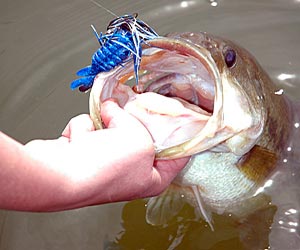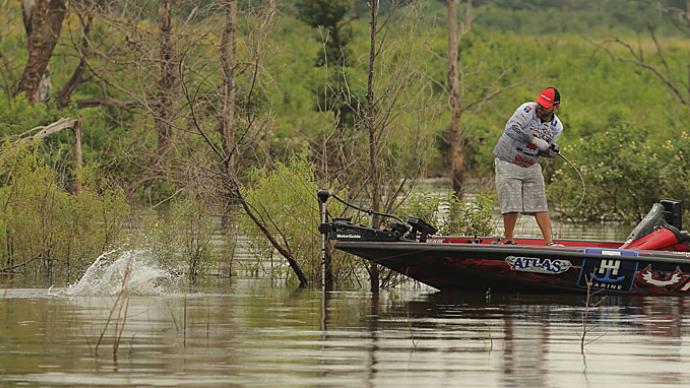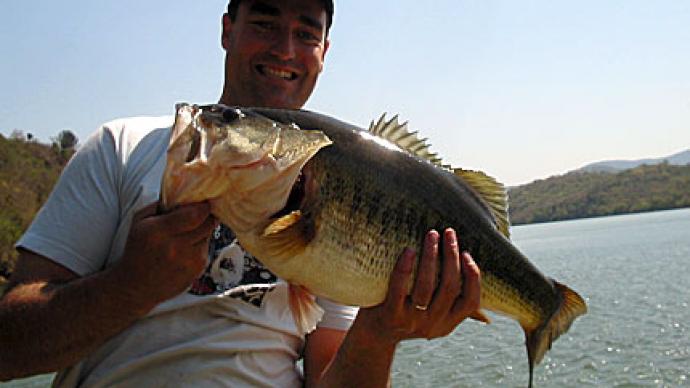
In today's bass fishing, when so many tricks and techniques come and go by the wayside, two techniques will be here for a long time. These two techniques have become to bass anglers what the ever-popular Carolina rig has, a vital part of their fishing arsenal. I'm talking about, of course, flipping and pitching.
Flipping involves peeling off about 50 to 75 percent or more line than the length of the rod and simply feeding the line back through the guides as you drop and lift the rod. Pitching involves releasing the lure from your hand with an underhand pitching movement as you let the line feed through the guides while you thumb the spool.
Pitching and flipping are lure-specific ways to fish. By that, I mean only a few baits are used with these techniques, which are dictated by the types of cover we fish. For example, You can pitch a slow, stationary bait such as a jig or worm or a faster-moving bait such as a spinnerbait. Flipping a bait is usually only done with a stationary bait, whether plastic or pork. By the way, it is not recommended to pitch crankbaits.
You can pitch or flip docks, grass, wood, or other types of cover that you feel are not easy to cast in the usual manner. The advantage of these techniques is that you can make a quiet presentation while reaching places with pinpoint accuracy that standard techniques won't let you.
Docks are a perfect place to use these techniques. You can flip or pitch under a dock anywhere from two to six feet.
The rod most often used for these two techniques ranges from six-and-a-half to seven-and-a-half feet in length. The best ones for the task are rated from medium-heavy to heavy. Reel choice should have a free spool setting so that it flows easily under your thumb as you release the lure. The line you want to use will typically be one of the more abrasion-resistant types. You pick the brand you are most comfortable with. Using braided or monofilament is up to you. I use at least 20- to 25-pound test and almost exclusively use fluorescent high-visibility fluorocarbon line. This is invaluable if you are a line watcher like I am. If you are not, you should be when using these two techniques.
One of the best ways to practice flipping and pitching is to get in the backyard and place five to seven bowls about two to four feet apart. Place these bowls from five to twenty feet away from where you will be standing. You will want to stand on a higher object than the ground to simulate your boat. Perhaps two to three feet above your bowl setup should do.
When you are first learning, use a heavier-than-normal weight. Perhaps a 3/4- or 1-ounce jig pitched or flipped will give you the "feel" until you find a rhythm and technique that is smooth enough for you to size down in weight. Simply practice until you can put the bait in the bowls without them popping out or making a loud clunk. You could even put some water in the bowls to see how softly you can pitch or flip into them. The less splash, the less noise you will make in actual use when flipping or pitching. And in some cases, a quiet and almost "splashless" entry of the bait into the water is necessary.
A couple of productive techniques that are not necessarily the norm can be used. For instance, you are bed fishing, and no fish react to your pitched or flipped bait. Here is a technique that is deadly if fished in an open area. You should use about a 1/2-ounce weight. Next, add a bead and a swivel. Next, tie on anywhere from 12 to 18 inches of heavy line. Then, put on a floating jerkbait. Pitch or flip the bait onto the bed. The fish might spook at first, but slowly lower your rod tip when it comes back and let the floating jerkbait slide freely through the weight. Then, let it suspend right over the bed. Raise and lower your rod slowly, and you will see the action I am describing. This can be the ticket when all else fails.
Have you ever thought about flipping for crappie? Why not. In the spring, when the crappie are in pre-spawn, spawn, or post-spawn, how often have you wanted to put a live minnow in their bedroom? Take a six-and-a-half-foot medium-action spinning rod with about 12-pound test on it. Tie a crappie hook on the line. Tie a rubber band on the line there, depending on your fishing depth. Clip the ends to have a small knot at the desired depth. Now, place a slip bobber in the middle. You can now pitch that minnow right where you want and as quietly as you like. This is an excellent technique when pitching the weeds they are bedding in.
You can pitch or flip your baits almost any month of the year. However, these two techniques are probably most often done from early spring until late fall. You can flip or pitch treetops in creek channels as the water warms in early spring, even though you might be fishing in 20 feet of water. Or you can pitch or flip in 12 inches of water or less in weeds and bullrushes throughout these months.
Of course, when pitching or flipping, you will want to use as light a bait as possible so as not to spook the fish. Worms with a 1/8-ounce weight pegged or 3/16- to 1/ 4-ounce jigs with pork trailers should be the ticket in shallow water. Jigs and worms with up to a 1-ounce weight may be necessary to penetrate thick weeds such as hydrilla.
So the next time you decide to go fishing and your regular techniques aren't working, why not try flipping or pitching? You just might catch the fish of a lifetime. As always, if the engine is running, make sure everyone is strapped and wrapped and has, as I like to call it, your "live switch" attached to your life jacket.




